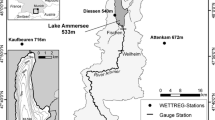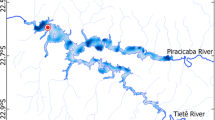Abstract
This research investigates the effect of climate change on the thermal structure of lakes in response to watershed hydrology. We applied a hydrodynamic water quality model coupled to a hydrological model with a future climate scenario projected by a GCM A2 emission scenario to the Yongdam Reservoir, South Korea. In the climate change scenario, the temperature will increase by 2.1°C and 4.2°C and the precipitation will increase by 178.4 mm and 464.4 mm by the 2050 and 2090, respectively, based on 2010. The pattern changes of precipitation and temperature increase due to climate change modify the hydrology of the watershed. The hydrological model results indicate that they increase both surface runoff itself and temperature. The reservoir model simulation with the hydrological model results showed that increasing air temperature is related to higher surface water temperature. Surface water temperature is expected to increase by about 1.2°C and 2.2°C from the 2050 and 2090, respectively, based on the 2010 results. The simulation results of the effects of climate warming on the thermal structure of the Asian Monsoon Area Lake showed consistent results with those of previous studies in terms of greater temperature increases in the epilimnion than in the hypolimnion, increased thermal stratification, and decreasing thermocline depths during the summer and fall. From this study, it was concluded that the hydrodynamic water quality model coupled to the hydrological model could successfully simulate the variability of the epilimnetic temperature, changed depth and magnitude of the thermocline and the changed duration of summer stratification.















Similar content being viewed by others
References
An KG (2001) Seasonal patterns of reservoir thermal structure and water column mixis and their modifications by interflow current. Korean J Limnl 34(1):9–19
Adrian R, O’Reilly CM, Zagarese H, Baines SB, Hessen DO, Keller W, Livingstone DM, Sommaruga R, Straile D, Van Donk E, Weyhenmeyer GA, Winder M (2009) Lakes as sentinels of climate change. Limnol Oceanogr 54:2283–2297
Albek M, Öğütveren UB, Albek E (2004) Hydrological modeling of Seydi Suyu watershed (Turkey) with HSPF. J Hydrol 285:260–271
Arhonditsis GB, Brett MT, DeGasperi CL, Schindler DE (2004) Effects of climatic variability on the thermal properties of Lake Washington. Limnol Oceanogr 49:256–270
Bicknell BR, Imhoff JC, Kittle JL, Donigian AS, Johanson RC (1993) Hydrological Simulation Program-FORTRAN user’s manual for release 10. Environmental Research Laboratory Office of Research and Development US Environmental Protection Agency, Athens
Bicknell BR, Imhoff JC, Kittle JL, Jobes TH Jr, Donigian AS Jr (2001) Hydrological Simulation Program—Fortran, user’s manual for version 12. U.S. Environmental Protection Agency, Environmental Research Laboratory, Athens
Binkley D, Brown RC (1993) Forest practices as nonpoint sources of pollution in North America. Water Resources Bull 29(5):729–740
Boehrer B, Schultze M (2008) Stratification of lakes. Rev Geophys 46:RG2005. doi:10.1029/2006RG000210
Bouraoui F, Wolfe ML (1990) Application of hydrologic models to rangelands. J Hydrol 121:173–191
Carpenter SR, Benson BJ, Biggs R, Chipman JW, Foley JA, Golding SA, Hammer RB, Hanson PC, Johnson PTJ, Kamarainen AM, Kratz TK, Lathrop RC, McMahon KD, Provencher B, Rusak JA, Solomon CT, Stanley EH, Turner MG, Vander Zanden MJ, Wu CH, Yuan H (2007) Understanding regional change: comparison of two lake districts. Bioscience 57(4):323–335
Chanasyk DS, Mapfumo E, Willms W (2003) Quantification and simulation of surface runoff from fescue grassland watersheds. Agric Water Manage 59:137–153
Chen YD, Carsel RF, Mccutcheon SC, Nutter WL (1998a) Stream temperature simulation of forested riparian areas: I. Watershed-scale model development. J Environ-ASCE 124:304–315
Chen YD, Mccutcheon SC, Norton DJ, Nutter WL (1998b) Stream temperature simulation of forested riparian areas: II. Model application. J Environ-ASCE 124(4):316–328
Coats R, Perez-Losada J, Schladow G, Richards R, Goldman C (2006) The warming of lake Tahoe. Clim Chang 76:121–148
Cole T, Buchak EM (1995) CE-QUAL-W2: A two dimensional, laterally averaged, hydrodynamic and water quality model, Version 2.0 user’s manual. Instructional report EL-95-1, U.S. Army Engineer Waterways Experiment Station, Vicksburg, MS
Donigian AS, Crawford NH (1976) Modelling nonpoint pollution from the land surface. Environmental Research Laboratory, AthensGA
Donigian AS, Imhoff JC, Bicknell BR, Kittle JL (1984) Application guide for Hydrological Simulation Program-FORTRAN (HSPF). U.S. Environmental Protection Agency
Edinger JE, Buchak EM, Merritt DH (1983) Longitudinal-vertical hydrohynamics and transport with chemical equilibria for Lake Powell and Lake Mead. In: French RH (ed) Salinity in watercourses and reservoirs. Butterworth Publishers, Stoneham, pp 213–222
Elo A, Huttula T, Peltonen A, Virta J (1998) The effect of climate change on the temperature conditions of lakes. Boreal Environ Res 3:137–150
Ford DE (1990) Reservoir transport process. In: Thornton KW et al (eds) Reservoir limnology: ecological perspectives. Wiley, New York
Fowler HJ, Blenkinsop S, Tebaldi C (2007) Linking climate change modeling to impacts studies: recent advances in downscaling techniques for hydrological modeling. Int J Climatol 27:1547–1578
Garvey E, Tobiason JE, Hayes R, Wolfram E, Reckhow DA, Make JW (1998) Coliform transport in a pristine reservoir: Modeling and field studies. Water Sci Technol 37:137–144
Gerten D, Adrian R (2000) Climate-driven changes in spring plankton dynamics and the sensitivity of shallow polymictic lakes to the North Atlantic Oscillation. Limnol Oceanogr 45:1058–1066
Göncü S, Albek E (2010) Modeling climate change effects on streams and reservoirs with HSPF. Water Resour Manag 24:707–726
Grotch SL, MacCracken MC (1991) The use of general circulation models to predict regional climatic change. J Climate 4:286–303
Hampton SE, Izmest’eva LR, Moore MV, Katz SL, Dennis B, Silow EA (2008) Sixty years of environmental change in the world’s largest freshwater lake-Lake Baikal, Siberia. Glob Change Biol 14:1947–1958
Hostetler SW, Small EE (1999) Response of North American freshwater lakes to simulated future climates. J Am Water Resour Assoc 35(6):1625–1637
Houghton JT, Ding Y, Griggs DJ, Noquer M, van der Linden PJ, Dai X, Maskell K, Johnson CA (2001) Climate change 2001: The scientific basis. Cambridge University Press, pp 881
Hu Z-Z, Latif M, Roeckner E, Bengtsson L (2000) Intensified Asian summer monsoon and its variability in a coupled model forced by increasing greenhouse gas concentrations. Geophys Res Lett 27:2681–2684
Intergovernmental Panel on Climate Change (IPCC) (2007) Climate change 2007: The physical science basis. Cambrige Univ. Press, New York
Jacomino VMF, Fields DE (1997) A critical approach to the calibration of a watershed model. J Am Water Resour Assoc 33(1):43–154
Kim BC, Park JH, Choi KS, Hwnag GS (1997) Eutrophication of large freshwater ecosystems in Korea. In: International symposium on eutrophication and water resources management and the 30th Annual meeting of the KSL. Korean Soc of Limnol
Kim BS, Kim BK, Kwon HH (2011) Assessment of the impact of climate change on the flow regime of the Han River basin using indicators of hydrologic alteration. Hydrol Process 25:691–704
Komatsu E, Fukushima T, Harasawa H (2007) A modeling approach to forecast the effect of long-term climate change on lake water quality. Ecol Model 209:351–366
Kwon HH, Kim BS (2009) Development of statistical downscaling model Using nonstationary Markov Chain. J Korean Water Resour As 42(3):213–225
Lal M, Meehl GA, Arblaster JM (2000) Simulation of Indian summer monsoon rainfall and its intraseasonal variability. Regional Environ Change 1:163–179
Lal M, Nozawa T, Emori S, Harasawa H, Takahashi K, Kimoto M, Abe-Ouchi A, Nakajima T, Takemura T, Numaguti A (2001) Future climate change: Implications for Indian summer monsoon and its variability. Curr Sci 81:1196–1207
Laroche AM, Gallichand J, Lagace R, Pesant A (1996) Simulating atrazine transport with HSPF in an agricultural watershed. J Environ-ASCE 122(7):622–630
Liao HH, Tim US (1997) An interactive modeling environment for nonpoint source pollution control. Water Resources Bull 33(3):591–603
Livingstone DM (2003) Impact of secular climate change on the thermal structure of a large temperature central European lake. Clim Chang 57:205–225
Livingstone DM, Dokulil MT (2001) Eighty years of spatially coherent Austrian lake surface temperatures and their relationship to regional air temperature and the North Atlantic Oscillation. Limnol Oceanogr 46(5):1220–1227
Livingstone DM, Lotter AF (1998) The relationship between air and water temperatures in lakes of the Swiss Plateau: A case study with palaeolimological implications. J Paleolimnol 19:181–198
Martin JL (1988) Application of two-dimensional water quality model. J Environ Eng-ASCE 114:317–336
McCormick MJ, Fahnenstiel GL (1999) Recent climatic trends in nearshore water temperatures in the St. Lawrence Great Lakes. Limnol Oceanogr 44:530–540
Meehl GA, Arblaster JM (2003) Mechanisms for projected future changes in south Asian monsoon precipitation. Clim Dyn 21:659–675
Moore LW, Chew CY, Smith RH, Sahoo S (1992) Modeling of best management practices on North Reelfoot Creek, Tennessee. Water Environ Res 64(3):241–247
Mortsch LD, Quinn FH (1996) Climate change scenarios for Great Lakes Basin ecosystem studies. Limnol Oceanogr 41(5):903–911
Nash JE, Sutcliffe JV (1970) River flow forecasting through conceptual models. Part 1. A discussion of principle. J Hydrolo 10:282–290
O’Reilly CM, Alin SR, Plisnier PD, Cohen AS, McKee BA (2003) Climate change decreases aquatic ecosystem productivity in Lake Tanganyika, Africa. Nature 424:766–768
Park GA, Ahn SR, Lee YJ, Shin HJ, Park MJ, Kim SJ (2009) Assessment of climate change impact on the inflow and outflow of two agricultural reservoirs in Korea. Trans ASABE 52(5):1869–1883
Parry ML, Canziani OF, Palutikof JP, Linden PJ, Hanson CE [eds] (2007) Climate change 2007 – impacts, adaptation and vulnerability. Contribution of Working Group II to the Fourth Assessment Report of the Intergovernmental Panel on Climate Change. Cambridge Univ. Press
Pham SV, Veavitt PR, McGowan S, Peres-Nato P (2008) Spatial variability of climate and land-use effects on lakes of the northern Great Plains. Limnol Oceanogr 53:728–742
Razavian D (1990) Hydrologic responses of an agricultural watershed to various hydrologic and management conditions.Water Resources Bull 26(5):777–785
Robertson DM, Ragotzkie RA (1990) Changes in the thermal structure of moderate to large sized lakes in response to change in air temperature. Aquat Sci 52:360–380
Schmidli J, Frei C, Vidale PL (2006) Downscaling from GCM precipitation: a benchmark for dynamical and statistical downscaling methods. Int J Climatol 26:679–689
Soballe DM, Kimmel BL, Kennedy RH, Gaugush RF (1992) Lentic systems; reservoirs. In: Hackney CT, Adams SM, Martin WH (eds) Biodiversity of the southeastern United States aquatic communities. Wiley, New York
Stefan HG, Fang X, Hondzo M (1998) Simulated climate change effects on year-round water temperatures in temperate zone lakes. Clim Chang 40:547–576
Straile D (2002) The North Atlantic oscillation synchronizes food-web interactions in central European lakes. Proc Royal Soc B Bio 269:391–395
Thornton KW (1990) Perspectives on reservoir limnology. In: Thornton KW et al (eds) Reservoir Limnology: ecological perspectives. Wiley, New York
Tsihrintzis VA, Fuentes HR, Gadipudi RK (1996) Modeling prevention alternatives for nonpoint source pollution at a well field in Florida. Water Resources Bull 32(2):317–331
Vincent WF, Gibbs MM, Spigel RH (1991) Eutrophication processes regulated by a plunging river inflow. Hydrobiologia 226:51–63
Wetzel RG (1983) Limnology. W.B. Saunders Co., Philadelphia
Williamson CE, Dodds W, Kratz TK, Palmer M (2008) Lakes and streams as sentinels of environmental change in terrestrial and atmospheric processes. Front Ecol Environ 6:247–254
Acknowledgement
This work was supported by the National Research Foundation of Korea (NRF) grant funded by the Korea government (MEST) (No. 2011–0001286). In addition, we are grateful to Dr. Kim, Byung-Sik for the supply of future climate data.
Author information
Authors and Affiliations
Corresponding author
Rights and permissions
About this article
Cite this article
Lee, H.W., Kim, E.J., Park, S.S. et al. Effects of climate change on the thermal structure of lakes in the Asian Monsoon Area. Climatic Change 112, 859–880 (2012). https://doi.org/10.1007/s10584-011-0233-3
Received:
Accepted:
Published:
Issue Date:
DOI: https://doi.org/10.1007/s10584-011-0233-3




